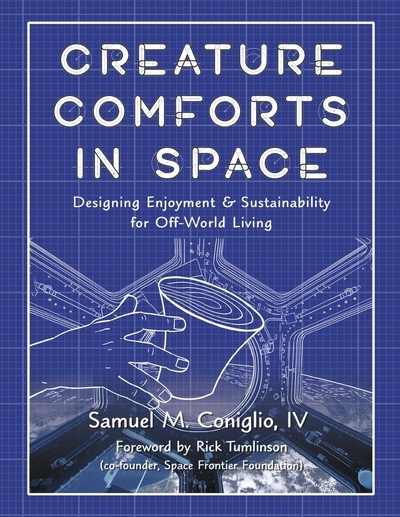 |
By Jeff Foust
Monday, July 29, 2024
Amenities in space: designing pleasurable and sustainable experiences for out-of-this-world living
By Samuel M. Coniglio, IV
Baby Book, 2024
Paperback, 162 pp., illus.
Publication number: 979-8-21824-640-2
US$33
In May, just before the start of the International Space Development Conference in Los Angeles, the Space Tourism Conference was held. The day-long event focused less on the technology of space tourism (spacecraft and space stations) than on the experience, with sessions on space entertainment, food, and “lifestyle brands.” The session offered a very forward-looking view of space travel, not unlike what might have been presented ten or twenty years ago, given the slow pace of progress in commercial human spaceflight.
One session focused on creating “amenities” for future commercial space travelers—“those hard-to-describe things that make life more enjoyable, have mental health benefits, and are fun,” writes Sam Coniglio in his new book, Amenities in spaceExamples of these amenities range from cocktails and hot meals to fluffy towels, sweatpants and silence. They don't typically exist on current spaceflight, but they may be essential for a future in which more people live and work in space for extended periods.
| There is very little investment in these concepts because of their utilitarian focus. Coniglio includes some images of the ISS bathrooms and asks: “Can you design them to look better?” |
Coniglio discusses many of these topics in the book, from the kitchen to the shower to the inevitable discussion of toilets. He approaches the topic from his own interdisciplinary background, which includes working as a technical writer for NASA and developing “drinkbots,” or robots that make drinks. A decade ago, inspired by NASA astronaut Don Pettit’s creation of a zero-gravity coffee cup that makes use of surface tension and capillary action, he developed a zero-gravity cocktail glass using the same principles. (The glass never flew on the ISS, he said, because of NASA public affairs’ nervousness about anything that might be associated with drinking alcohol in space.)
In the book, he discusses the challenges posed by things we take for granted on Earth, such as preparing a meal in a kitchen or taking a shower. Microgravity is perhaps the biggest obstacle, but there are also the limitations of volume and the limited resources available on spacecraft. However, he argues that there are potential ways to address those challenges, citing several concepts including his own designs. One interesting concept is his “garden shower” for a shower that includes moss growing on the bottom half of the cylindrical showerhead: the moss would filter the water, he argues, while also providing some psychological benefits.
It’s not clear when or if any of the concepts he describes in the book will ever be implemented. Amenities on the ISS today are limited, with an environment he compares to an extreme campsite. There’s very little investment in these concepts given that utilitarian focus. Coniglio includes some images of toilets on the ISS and asks, “Can you design them to look better?” Right now, there’s no incentive for NASA or its contractors to design toilets to look better, only to make them work effectively and reliably.
However, at some point there may be a demand for toilets that work well and look good, as well as showers, cooking facilities and more. Commercial space stations proposed for launch in the next decade may still look fairly utilitarian, focusing on the needs of NASA, other government agencies and corporate users. (Axiom Space, several years ago, showed Interior designs of a future habitable module for the space station developed by Philippe Starck (At the very least, it will look better than the ISS.) But eventually, even corporate researchers will want the option of relaxing at the end of a long day with a nice meal and a cocktail, just like on Earth. A few creative amenities will go a long way toward improving the experience for researchers and tourists alike.
Note: We are moderating comments. There will be a delay in posting comments and there is no guarantee that all submitted comments will be posted.
Please enable JavaScript to view the comments powered by Disqus.